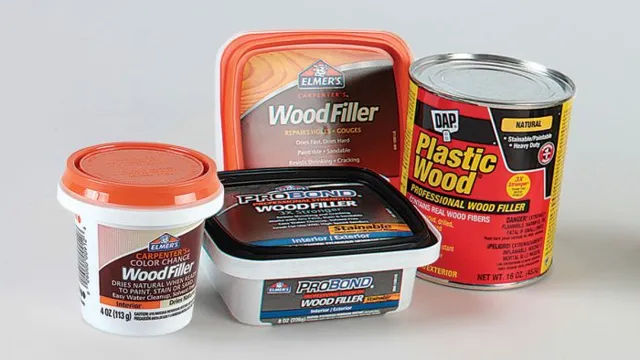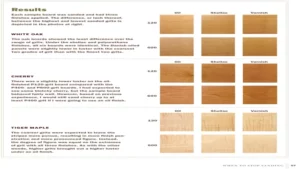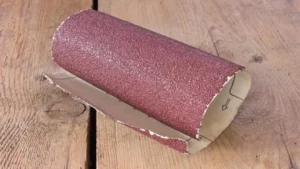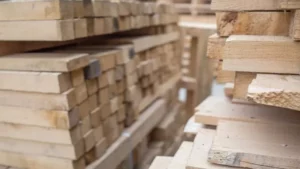If you’ve ever filled gaps, holes, or cracks in wood with wood filler, you know that sometimes it can be challenging to get the perfect consistency. Whether you’ve used a pre-mixed wood filler or created your own with sawdust and glue, sometimes it can be too thick to spread evenly, or it might dry too quickly, leaving a lumpy mess. But don’t worry, there is a solution.
In this article, we’ll discuss how to thin wood filler to make it easier to work with and achieve a flawless finish. So, grab your wood filler and let’s get started!
Introduction
If you’ve ever tried to apply wood filler and found it too thick, don’t worry – there’s an easy solution. Thinning out wood filler is a simple process that can be accomplished with just a few steps. Start by adding small amounts of water or mineral spirits to the filler, stirring the mixture thoroughly until it reaches the desired consistency.
Be sure to add the liquid slowly, so as not to over-thin the mixture. If you accidentally thin the filler too much, you can always add more filler to achieve the desired thickness. With this simple technique, you’ll be able to create a smooth, even surface for your wood projects every time.
Remember to use a flexible putty knife to apply the filler, apply it in thin layers, and let it dry completely before sanding or painting. So next time you need to thin wood filler, don’t panic – with a little bit of patience and experience, you’ll be able to achieve a professional-looking finish every time.
What is Wood Filler?
Wood filler is an essential product for any woodworker or DIY enthusiast who wants to achieve a smooth and polished finish on their projects. Essentially, wood filler is a putty-like substance that can be used to fill in cracks, gaps, and other imperfections in the wood surface. It is commonly made from a mixture of sawdust and a binding agent, such as epoxy or polyurethane.
The main advantage of wood filler is that it can be sanded, stained, and painted just like real wood, and it can also be used to improve the structural integrity of wood products. Whether you’re repairing a damaged piece of furniture, or just want to achieve a flawless finish on your woodwork, using wood filler is an easy and effective solution. So, the next time you’re working on a wood project, don’t forget to stock up on wood filler!
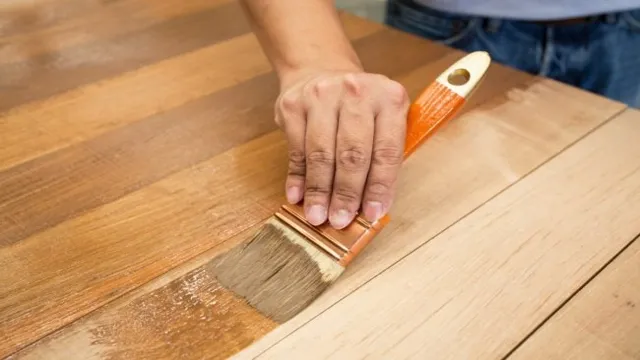
Why Thin Wood Filler?
Thin wood filler is a popular choice for many woodworkers and DIY enthusiasts for various reasons. Firstly, it is thinner in consistency compared to regular wood fillers, which makes it easier to work with, especially when filling in small cracks, holes, and imperfections. Thin wood filler also dries faster and harder than other types of wood fillers, making it ideal for projects that require a smooth and seamless finish.
Its ability to be sanded, stained, or painted over once it has fully dried makes it a versatile option for various woodworking projects. Another benefit of thin wood filler is that it is suitable for use on both hardwood and softwood without affecting the wood’s natural color. Overall, thin wood fillers are a reliable choice for anyone looking to achieve a professional-looking finish on their woodworking projects while saving time and effort.
Tools Needed
If you’ve ever used wood filler before, you know that it tends to dry out and become difficult to work with over time. Luckily, there’s an easy solution to this problem – thinning out your wood filler! To do this, you’ll need a few tools on hand. First, you’ll need your wood filler.
Choose a high-quality product that you trust to get the job done right. Next, you’ll need a stirring stick or similar tool. You can use a disposable plastic spoon or popsicle stick if you don’t have anything else on hand.
Finally, you’ll need some water. The amount of water you’ll need will vary depending on the consistency of your wood filler. Generally, you’ll want to add water a little bit at a time until you achieve the desired consistency.
Thinning out your wood filler has many benefits. Not only will it make the product easier to work with, but it can also help you achieve a smoother, more even finish. Keep in mind that over-thinning your wood filler can compromise its strength and durability.
It’s best to add water in small increments and test the consistency frequently until you achieve the desired result. With these simple tools and techniques, you’ll be able to thin out your wood filler like a pro and achieve the perfect finish every time.
Wood Filler
When it comes to using wood filler, you’ll need a few tools to get the job done right. The first tool you’ll need is a putty knife. This tool will help you apply the wood filler to the damaged area in a precise and controlled way.
You’ll also need sandpaper. Once the wood filler has dried, you’ll need to sand it down to make it smooth and flush with the surrounding area. For a small job, you can use sandpaper by hand, but for larger jobs, an electric sander will make the process much faster and easier.
You may also need a hammer and nail set if there are any nails that need to be sunk below the surface of the wood before applying the filler. Finally, you’ll need a clean, damp cloth to wipe away any excess wood filler and keep your work area tidy. With these tools in hand, you’ll be able to use wood filler with ease and achieve professional results.
Solvent
When it comes to using solvents for different tasks, it is important to have the right tools on hand. One of the most important tools you need is a sturdy and high-quality container that is designed to hold and transport the solvent safely. You should also have a set of appropriate safety gear, including gloves, goggles, and a face mask to protect yourself from potential fumes and splashes.
Another important tool to have is a stirrer or agitator to ensure the solvent is well-mixed and any contaminants are fully dissolved. Additionally, you may need a heating element to apply heat to the solvent, and a cooling element to cool it down either before or after use. Whether you are using solvents in a laboratory or at home, having these tools on hand can help ensure your safety and make the process much easier.
So, make sure you invest in high-quality tools to get the best results and protect yourself from potential harm while working with solvents.
Mixing Container
If you’re planning on mixing and applying chemicals or ingredients, having a reliable mixing container is essential. There are many types of mixing containers available, including plastic buckets, metal cans, and glass jars. When choosing a container, consider the material’s durability, size, and compatibility with the substances you’ll be mixing.
Other tools needed for mixing include a stirring tool, such as a spoon, spatula, or mixer, as well as measuring cups and spoons to ensure accuracy. It’s essential to mix your ingredients thoroughly to ensure that they’re evenly distributed and that the mixture is of consistent quality. A poorly mixed product could lead to unexpected results, including ineffectiveness, damage to surfaces, or even health risks.
So, when it comes to mixing containers, choose wisely and prioritize safety and quality.
Thin Wood Filler: Step-by-Step Guide
If you’ve ever used wood filler before, you know how handy it is for filling in cracks and holes in wood surfaces. However, sometimes the consistency of the filler can be too thick for the job at hand. That’s why thinning it out can make it easier to work with and achieve a smoother finish.
Here’s how to thin wood filler: First, add a small amount of water to the filler and mix it in using a stirring tool like a putty knife or a paint stirrer. Keep adding water and mixing until you get your desired consistency. Be careful not to add too much water at once, as this can make the filler watery and difficult to work with.
Once you have the right consistency, you can start filling in the area that needs repair. Thin wood filler can still be used for small gaps and holes, but by thinning it out, you can make it easier to apply to larger areas. By following these simple steps, you can achieve a more polished wood surface with less hassle.
Step 1: Pour the wood filler to the mixing container
If you’re looking to repair a wooden surface, thin wood filler is a great solution to fill in those cracks and gaps. To start the process, you’ll need a mixing container and a putty knife. Pour the wood filler into the mixing container and be mindful of the amount you use as you don’t want to waste any of it.
The consistency of the wood filler should be similar to that of toothpaste, so make sure you add the right amount of water. Mix the filler and water well until you get a smooth and paste-like mixture. It’s important not to make the mixture too thick or too watery; a balanced consistency will make it easier to apply.
Once you have your mixture ready, it’s time to apply it to the wooden surface. Use your putty knife to spread the thin wood filler over the cracks and gaps in the wood, making sure to fill them in evenly. With a little bit of patience and care, the wood filler will be able to mend the wooden surface, leaving it looking as good as new.
Step 2: Add the solvent
Now that you have mixed the wood filler, it’s time to add the solvent. This step is crucial because it determines the consistency of the filler that will adhere to the surface you’re repairing. You want to add the solvent slowly to avoid over-thinning the filler, causing it to lose its structural integrity.
Begin by adding a small amount of solvent and mixing it thoroughly into the filler with a putty knife. Keep adding the solvent until the mixture becomes spreadable but not runny. The ideal consistency is like peanut butter, thick enough to hold its shape but still easy to spread on the surface.
Once you reach this consistency, your wood filler is ready to use. Remember, each solvent has different thinning properties, so it’s best to follow the manufacturer’s instructions or experiment on a small test area before applying the filler to the entire surface. Incorporating this step will ensure that you get the most out of your wood filler and achieve a seamless, durable repair.
Step 3: Stir the mixture
If you’re looking for a way to fix those unsightly wood cracks and holes, thin wood filler may just be the answer to your prayers. Once you’ve combined the wood filler with water and mixed it thoroughly, it’s time to move on to the next step: stirring the mixture. This will ensure that the wood filler is evenly distributed and easy to work with.
Using a plastic putty knife, stir the mixture until it reaches a smooth and creamy consistency. Be sure to scrape the sides and bottom of the container to prevent any clumps from forming. The stirring process shouldn’t take more than a few minutes, but it’s vital in achieving a perfect finish.
Once you’re happy with the consistency, you’re ready to apply the thin wood filler to any imperfections in your woodwork. With patience and a steady hand, you’ll be able to create a flawless result that will last for years to come.
Step 4: Test the consistency
Testing the consistency of your thin wood filler is a crucial step in achieving a smooth and flawless finish. To do this, you can use a small amount of the wood filler and apply it to an inconspicuous area of your project. Make sure to spread the filler evenly and let it dry completely before checking the consistency.
If the filler has dried with small holes or cracks, it may be too thin and require additional layers. On the other hand, if the filler dried with an uneven surface, it may be too thick and require sanding or smoothing to achieve a more consistent finish. Remember to test the consistency before applying the filler to the rest of your project, as it can affect the overall look and feel of your final product.
By taking the time to test the consistency, you can ensure that your thin wood filler achieves the desired finish and adds value to your project.
Tips and Tricks
If you’ve ever worked with wood filler, you know how important it is to have the right consistency to achieve a smooth and even finish. If your wood filler is too thick, it can be difficult to spread evenly and can leave bumps or clumps on the surface. Thankfully, thinning wood filler is a simple process that anyone can do.
To thin your wood filler, you can add a small amount of water, acetone, or mineral spirits to the mixture. Start by adding a small amount of your desired thinner and stir well to combine. Test the consistency and add more thinner in small increments until you reach your desired consistency.
Keep in mind that thinning your wood filler may affect its drying time, so be sure to test out a small patch before committing to the entire project. With these tips and tricks, you can achieve a smooth and flawless finish on your wood projects.
Use the right amount of solvent
When it comes to using solvents, it’s crucial to use the right amount. Adding too much or too little can lead to issues with your final product. You want to ensure that you have enough solvent to dissolve your solute completely, but not so much that it affects the overall concentration of your solution.
Additionally, using too much solvent can also increase your costs and waste materials. It’s always best to follow the guidelines provided by the manufacturer or a trusted source and use a measuring instrument for accuracy. By using the right amount of solvent, you’ll avoid potential problems and achieve the desired results for your project.
Remember, it’s better to be safe than sorry!
Stir thoroughly
When it comes to cooking, one of the most crucial steps is ensuring that all the ingredients are mixed thoroughly. This step can make all the difference between a dish that tastes amazing and one that falls flat. To stir thoroughly, start by using a sturdy utensil to ensure that all the ingredients are evenly distributed throughout the mixture.
You want to avoid having pockets of unmixed ingredients that can throw off the flavor and texture of the dish. Take your time when stirring, making sure to get into all the corners of the pot or bowl. Don’t be afraid to use a circular motion, as this can help to break up any clumps of ingredients.
Stirring will also help to evenly distribute any spices or seasoning that you add, ensuring that every bite is full of flavor. So, when it comes to cooking, don’t skimp on this important step. Stir thoroughly for a delicious end result every time.
Test the consistency as you go
As you write your blog, it’s important to test the consistency of your content every step of the way. Consistency ensures that your readers know what to expect when they come to your blog, and it helps to build trust and loyalty among them. One of the best ways to do this is to create an editorial calendar that outlines the topics you plan to cover over the course of a month or even a year.
This will help you to stay focused and on track, and it will also help you to spot any holes or inconsistencies in your content. Be sure to test the consistency not only in the topics you cover, but also in your writing style, tone of voice, and overall message. This will help you to maintain a cohesive brand image and keep your readers coming back for more.
Remember, consistency is key when it comes to building a successful blog.
Conclusion
In conclusion, thinning wood filler is a simple but important task for achieving a professional finish on your woodwork. Just like adding milk to coffee, the right amount of thinner can make all the difference in achieving a smooth and consistent texture. So, don’t be afraid to experiment and find the perfect balance for your project.
And remember, when it comes to thinning wood filler, less is more – just like with your morning espresso!”
FAQs
What is wood filler and why is it used?
Wood filler is a putty-like material that is used to fill in gaps, holes or cracks in wood surfaces. It is used to create a smooth and even surface that is ready for staining, painting or varnishing.
How do you thin wood filler?
To thin wood filler, add small amounts of water or solvent to the mixture until it reaches the desired consistency. However, do not add too much as it can affect the quality and strength of the wood filler.
Can you use wood filler on outdoor projects?
Yes, there are wood fillers that are specifically designed for outdoor use. These types of wood fillers are resistant to water, weather and UV rays, making them ideal for outdoor projects.
How do you apply wood filler?
Apply wood filler using a putty knife or a scraper. Apply the filler in thin layers, allowing each layer to dry before adding more. Sand the surface smooth once the filler has hardened.
Can wood filler be sanded?
Yes, wood filler can be sanded once it has hardened. Use a fine-grit sandpaper to smooth out the surface and achieve a smooth finish.
How long does it take for wood filler to dry?
The drying time of wood filler depends on the type of filler used, the thickness of the layer applied and the temperature and humidity of the environment. Generally, it takes 2-4 hours for wood filler to dry.
Can you stain wood filler?
Yes, wood filler can be stained to match the surrounding wood. However, it is important to apply the stain evenly to avoid visible patches or color differences.
